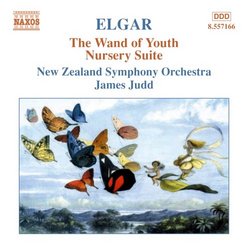| All Artists: Edward Elgar, James Judd, New Zealand Symphony Orchestra Title: Elgar: The Wand of Youth; Nursery Suite Members Wishing: 0 Total Copies: 0 Label: Naxos Release Date: 4/20/2004 Genre: Classical Styles: Forms & Genres, Theatrical, Incidental & Program Music, Symphonies Number of Discs: 1 SwapaCD Credits: 1 UPC: 747313216628 |
Search - Edward Elgar, James Judd, New Zealand Symphony Orchestra :: Elgar: The Wand of Youth; Nursery Suite
 | Edward Elgar, James Judd, New Zealand Symphony Orchestra Elgar: The Wand of Youth; Nursery Suite Genre: Classical
|
Larger Image |
CD Details |
CD ReviewsDreamily Nostalgic and Optimistic Elgar Superbly Played J Scott Morrison | Middlebury VT, USA | 05/01/2004 (5 out of 5 stars) "There is a childward-looking character in the music of Edward Elgar that casual listeners are often unaware of, although there is some degree of it in his best-known work, 'Enigma Variations.' This disc presents several works written specifically to look nostalgically towards a Victorian childhood. Indeed, some of the materials in Elgar's 1907 'Wand of Youth' suites were written in 1869 when Elgar was only twelve years old, music written for domestic use for a private Elgar family theatrical production. And the feeling in all the works heard here is that of the late Victorian household--belief in fairies, nursery tales, plays put on by the neighborhood children. This music is some of Elgar's most charming. It recalls a more innocent time, a time of optimism and the future stretching before all in its shining glory. Elgar was obviously fond of these materials and the feeling they evoked in him: he reused them several times. For instance, motifs from 'The Wand of Youth' were later used in an evening-long score of incidental music for a play, 'The Starlight Express,' (not to be confused with the sappy Andrew Lloyd Webber extravaganza of that name). And to continue that trend of reuse, Anthony Payne, when completing Elgar's unfinished Third Symphony, used part of 'The Waggon Passes' from 'The Nursery Suite' in his elaboration of its fourth movement. This nursery tale music fits perfectly in that grand symphony, demonstrating again how Elgar's serious music could sometimes be very close to his other, lighter, nostalgic vein. This disc contains 22 character pieces in all--thirteen from the two 'Wand of Youth' suites, two from 'Dream Children,' and seven from 'Nursery Suite.' Each of the individual pieces characterizes (and usually quite well) its title; in 'Wand of Youth' are pieces like 'Sun Dance' (a lively scherzo), 'Fairy Pipers' (the droning of musettes), the exquisite 'Slumber Scene' (the muted New Zealand Symphony strings are absolutely stunning here), 'Moths and Butterflies' (the spirit of Mendelssohn fairy music inhabits this lovely piece). You get the picture. There are virtuosic pieces like 'The Wild Bears' and artfully simple pieces like 'Fountain Dance.' 'Dream Children, Op. 43.' from 1902, is rarely heard these days, possibly because it is only two short pieces totalling 8 minutes or so. It is dreamily nostalgic; once again we are told that Elgar had sketched the basic materials many years earlier, well before he'd had his first successes as a composer.'Nursery Suite' from 1930, and thus one of Elgar's later works, was dedicated to the then Duke and Duchess of York (later King George VI and Queen Elizabeth) and to the young princesses Elizabeth (now Elizabeth II) and Margaret. Again, the character pieces comprising this suite are utterly descriptive. The previously mentioned 'The Waggon Passes' reminds one of Mussorgsky's 'Bydlo' from 'Pictures at an Exhibition' in that it describes the lumbering approach of a wagon, but it is in an entirely different harmonic language than Mussorgsky's. The suite opens with the dawn song 'Aubade,' which is lively enough to wake the children up but not frighten them. Interspersed throughout the suite are the 'Serious Doll,' a musing piece featuring solos from the wind principals, 'The Sad Doll,' a gently wistful waltz, and 'The Merry Doll,' which sounds like a child racing throughout the house, first jumping up and down on a bed, and then sprinting up and down stairs. 'Busy-ness' is a virtuosic scherzo. The suite ends with 'Dreaming,' the epitome of Elgar's gentle yearning for lost youth, his own and, unconsciously, that of the Victorian age of empire.The New Zealand Symphony Orchestra under Donald Judd has come in for extravagant praise from me for earlier issues like the Bernstein 'Jeremiah' Symphony and the fine Vaughan Williams disc that included the Fantasias on Greensleeves and on A Theme by Thomas Tallis. Somehow, while I wasn't watching, this group has become a major orchestra. The playing here is simply smashing. And a final word of praise must be said for the wonderful playing of the unnamed solo violinist (possibly their new concertmaster, Vesa-Matti Leppänen) in the cadenza and canzonetta in the final piece, 'Dreaming.' Strongly recommended.TT=66:47Scott Morrison"
|

 Track Listings (22) - Disc #1
Track Listings (22) - Disc #1